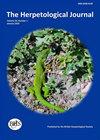The plasticity of metamorphic traits in the Chinese brown frog tadpoles fails to obey Richards' hypothesis
IF 1.1
4区 生物学
Q3 ZOOLOGY
引用次数: 0
Abstract
According to Richards' hypothesis, algae or cells in the intestinal tract has been considered the cellular inhibitory factor, when they fall off and hide in the faeces, excreted together with the faeces. If the animals feed on these faeces with algae or cells, and bring them into their systems, then the cellular inhibitory factor would play the main responsibility for growth inhibition. Here, we surveyed the effects of different combinations of faeces and food level on growth rates, survivorship, larval age and mass, and SVL at metamorphosis of the Chinese brown frog Rana chensinensis. Our results showed that food level can influence the length of the larval period of Chinese brown frog tadpoles, suggesting that delayed metamorphosis is caused by low food supply, indicative of a function of effective energy. Our data also clearly indicated that tadpoles in the presence of faeces were on average larger in body mass than those in the absence of faeces, which failed to obey Richards' hypothesis. Moreover, our results found evidence that faeces have a positive effect on the growth rate of tadpoles. Thus, there is no evidence for Richards' hypothesis, suggesting that this novel mechanism is selected for where coprophagy is likely to prove profitable, irrespective of the abundance of alternative food. Keywords: Rana chensinensis, Richards' hypothesis, faecal material, mass at metamorphosis, growth rate中国棕蛙蝌蚪变形特征的可塑性不符合理查兹的假设
根据Richards的假说,肠道中的藻类或细胞被认为是细胞抑制因子,当它们脱落并隐藏在粪便中,与粪便一起排出时。如果动物以这些粪便为食,并将藻类或细胞带入体内,那么细胞抑制因子将发挥抑制生长的主要作用。本文研究了不同粪便和食物水平组合对中国蛙(Rana chinsinensis)生长速率、存活率、幼虫龄和质量以及变态期SVL的影响。结果表明,食物水平会影响褐蛙蝌蚪幼虫期的长度,提示褐蛙蝌蚪的延迟变态是由食物供应不足引起的,表现为有效能量的函数。我们的数据还清楚地表明,有粪便的蝌蚪平均体重比没有粪便的蝌蚪大,这与Richards的假设不符。此外,我们的研究结果还发现了粪便对蝌蚪生长速度有积极影响的证据。因此,没有证据支持理查兹的假设,表明这种新机制被选择在食腐可能被证明有利可图的地方,而不管替代食物的丰富程度。关键词:中国林蛙,Richards假说,粪便物质,变态团块,生长速率
本文章由计算机程序翻译,如有差异,请以英文原文为准。
求助全文
约1分钟内获得全文
求助全文
来源期刊

Herpetological Journal
生物-动物学
CiteScore
2.40
自引率
10.00%
发文量
25
审稿时长
>12 weeks
期刊介绍:
The Herpetological Journal is the Society''s prestigious quarterly scientific journal.
 求助内容:
求助内容: 应助结果提醒方式:
应助结果提醒方式:


